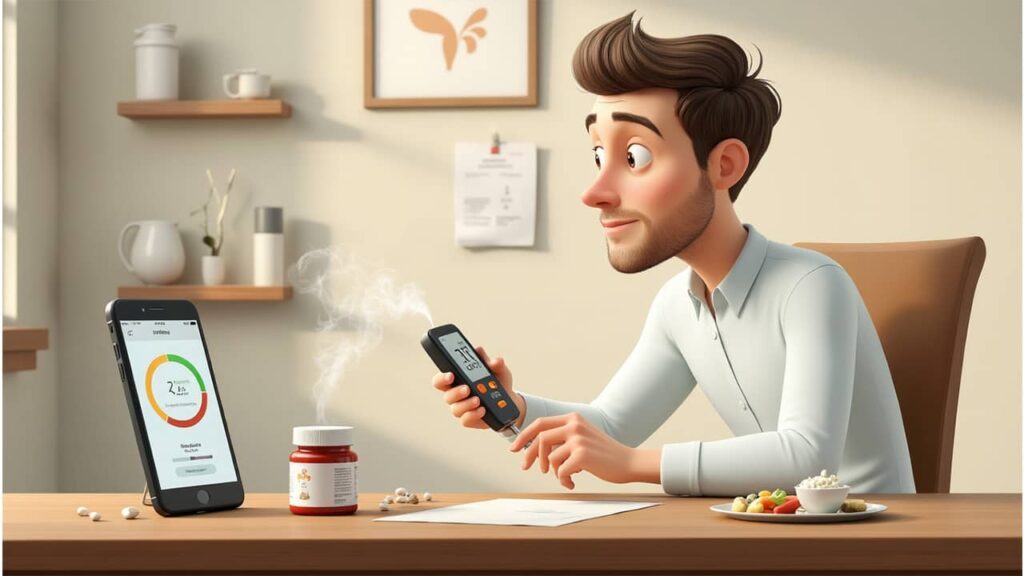What Is an Unsafe Blood Sugar Level? 7 Essential Facts, Symptoms, and Prevention Tips

Table of Contents
What Is an Unsafe Blood Sugar Level? This is a question that concerns millions of people worldwide, especially those living with diabetes, prediabetes, or other metabolic conditions.
Blood sugar also called blood glucose is the body’s primary source of energy, but when its levels rise too high or drop too low, the consequences can range from mild discomfort to severe, life-threatening emergencies.
An unsafe blood sugar level disrupts the body’s natural balance, affecting everything from brain function and energy levels to long term organ health.
In the short term, it can cause symptoms such as dizziness, confusion, or extreme fatigue. Over time, repeated episodes can increase the risk of heart disease, nerve damage, kidney problems, and vision loss.
Whether you’ve just been diagnosed, are monitoring your glucose as part of a healthy lifestyle, or are supporting a loved one, understanding these levels is a crucial part of proactive health management.
Recognizing the signs, knowing your personal target range, and taking steps to prevent dangerous fluctuations can help you maintain not only safe blood sugar levels but also a better quality of life.
In this article, we will explain What Is an Unsafe Blood Sugar Level?, how it is measured, the symptoms to watch for, and the steps you can take to prevent it.
You will also learn about tools, monitoring methods, and lifestyle strategies backed by evidence—that support long-term glucose stability.
Understanding Blood Sugar Levels

When learning about blood glucose, it’s important to first ask: What Is an Unsafe Blood Sugar Level?
This question helps set clear health targets and gives context to normal and abnormal readings. Blood sugar, or blood glucose, refers to the concentration of glucose in your bloodstream at any given time.
It primarily comes from carbohydrates in the foods you eat, which are broken down into glucose during digestion. Once in the bloodstream, glucose is transported to your cells, where it is used to produce energy.
The hormone insulin, produced by the pancreas, plays a crucial role in regulating these levels by helping cells absorb glucose.
When blood sugar rises after a meal, insulin signals cells to take in glucose and use it for immediate energy or store it for later use.
Conversely, when blood sugar drops such as between meals or during physical activity another hormone called glucagon signals the liver to release stored glucose to maintain stability.
Your blood sugar levels naturally fluctuate throughout the day. For example, they may be slightly higher in the morning due to the “dawn phenomenon,” a natural release of hormones that prepares your body to wake up.
After meals, levels rise temporarily, and during exercise, they may drop or stabilize depending on your body’s needs. These changes are normal as long as they remain within healthy ranges.
Here are the American Diabetes Association general guidelines for healthy blood sugar levels:
| Test | Normal Range | Pre-Diabetes | Diabetes |
|---|---|---|---|
| Fasting (8 hours) | 70–99 mg/dL | 100–125 mg/dL | 126 mg/dL or higher |
| 2 hours after eating | Less than 140 mg/dL | 140–199 mg/dL | 200 mg/dL or higher |
| HbA1c (3-month average) | Below 5.7% | 5.7%–6.4% | 6.5% or higher |
Note: These are general guidelines. Your personal target range may differ depending on your age, health condition, and medical advice.
Understanding how your body processes glucose and what causes it to move outside of safe limits—is the first step toward preventing unsafe blood sugar levels.
Defining an Unsafe Blood Sugar Level

Healthcare providers define What Is an Unsafe Blood Sugar Level? based on specific glucose measurements that indicate potential health risks.
An unsafe blood sugar level is any reading that falls outside the healthy range, either dropping too low (hypoglycemia) or rising too high (hyperglycemia).
These abnormal levels can cause immediate symptoms, impair daily functioning, and if left untreated lead to serious complications affecting multiple organs.
Unsafe levels are typically identified through blood glucose testing, which can be done in a fasting state, after meals (postprandial), or through an HbA1c test that reflects the average glucose over the past 2–3 months.
Low Blood Sugar (Hypoglycemia)
- Definition: Below 70 mg/dL.
- Short-term risks: Dizziness, confusion, blurred vision, and in severe cases, seizures or unconsciousness.
- Common triggers: Skipping meals, taking too much insulin or diabetes medication, prolonged intense exercise without adequate fueling, or excessive alcohol consumption without food.
Example: A person who skips breakfast and then does strenuous exercise may experience a sudden drop in blood sugar, leading to symptoms like shaking hands and lightheadedness.
This is why knowing What Is an Unsafe Blood Sugar Level? can help you act before symptoms escalate.
High Blood Sugar (Hyperglycemia)
- Definition: Fasting above 126 mg/dL or post-meal above 180 mg/dL.
- Short-term risks: Increased thirst, frequent urination, fatigue, and headaches.
- Long-term risks: Damage to blood vessels, nerves, kidneys, and eyes; increased cardiovascular risk.
- Common triggers: Consuming large amounts of refined carbs, stress, infections, physical inactivity, or insufficient insulin production.
Example: Someone who eats a large portion of white rice and soda without balancing it with protein or fiber may see their glucose levels spike above the safe range.
Understanding What Is an Unsafe Blood Sugar Level? also means recognizing when high readings persist for hours or days, which can silently damage organs.
Why These Levels Are Dangerous
Frequent or prolonged deviations from safe glucose ranges put extra strain on your body. High blood sugar can gradually damage small blood vessels and nerves, while low blood sugar can impair brain function in a matter of minutes. Both extremes demand prompt action to prevent emergency situations.
Symptoms of Unsafe Blood Sugar Levels

One of the easiest ways to identify What Is an Unsafe Blood Sugar Level? is by paying attention to the physical and mental signals your body gives you.
Symptoms vary depending on whether glucose levels are too low (hypoglycemia) or too high (hyperglycemia), and they can develop gradually or appear suddenly.
Recognizing these signs early can help prevent emergencies and long-term complications.
Signs of Low Blood Sugar (Hypoglycemia)
- Shakiness or trembling in the hands and body
- Sweating, often accompanied by clammy skin
- Dizziness or lightheadedness
- Sudden, intense hunger
- Confusion or difficulty focusing
- Rapid heartbeat or palpitations
- Tingling around the lips or fingertips
- Severe cases: seizures, unconsciousness, or inability to respond
Example: A person working long hours without eating may begin to feel weak, sweaty, and shaky a classic sign that their blood sugar is dropping dangerously low. Immediate action, such as consuming a fast-acting carbohydrate, is essential.
Signs of High Blood Sugar (Hyperglycemia)
- Increased thirst and dry mouth
- Frequent urination, especially at night
- Persistent fatigue or weakness
- Blurred vision
- Headaches
- Slow healing of cuts or wounds
- Unexplained weight loss (in prolonged cases)
- Irritability or difficulty concentrating
Example: After a large, high-carb meal, someone might notice they feel unusually tired, thirsty, and are making repeated trips to the bathroom clear signs of elevated blood sugar.
If you notice these signs frequently, it could indicate What Is an Unsafe Blood Sugar Level? that requires medical evaluation.
Why Recognizing Symptoms Early Matters
Low blood sugar can impair brain function within minutes, making it dangerous to drive, operate machinery, or even walk without support.
High blood sugar, if persistent, can quietly damage organs over time.
Understanding your body’s early warning signs allows you to take corrective action such as adjusting your diet, exercising, or checking your glucose before the situation escalates.
Causes of Unsafe Blood Sugar Levels

To understand What Is an Unsafe Blood Sugar Level?, it’s helpful to explore the various factors dietary, medical, and lifestyle that can disrupt glucose balance.
Blood sugar fluctuations often result from a combination of causes, and identifying the root problem is key to preventing dangerous highs and lows.
Dietary Factors
- High intake of refined carbs and sugar: Foods like white bread, sugary drinks, and desserts cause rapid spikes in blood glucose, often followed by a sharp drop.
- Skipping meals: Going long periods without eating can deplete the body’s glucose supply, leading to hypoglycemia.
- Overeating in one sitting: Consuming large portions can overwhelm the body’s ability to process glucose efficiently.
Example: Drinking a large soda on an empty stomach can cause a rapid glucose surge, followed by a crash, leaving you tired and irritable.
Medical Conditions
- Diabetes (Type 1 and Type 2): Impaired insulin production or resistance to insulin makes it difficult to regulate glucose.
- Insulin resistance: Common in prediabetes, this condition prevents cells from using glucose effectively.
- Hormonal disorders: Conditions like Cushing’s syndrome or hyperthyroidism can disrupt glucose metabolism.
- Certain medications: Steroids, diuretics, and some psychiatric drugs may affect blood sugar control.
If unmanaged, these conditions can contribute to What Is an Unsafe Blood Sugar Level? and its related complications.
Lifestyle Factors
- Physical inactivity: Lack of regular exercise reduces insulin sensitivity, making it harder to keep glucose stable.
- Chronic stress: Stress hormones like cortisol can raise blood sugar.
- Poor sleep patterns: Sleep deprivation affects insulin regulation and appetite control.
- Excessive alcohol consumption: Alcohol can cause both dangerous lows and highs, depending on timing and food intake.
Example: A sedentary office worker under high stress who sleeps poorly and skips meals is at risk for both hypoglycemia and hyperglycemia.
How Multiple Factors Interact
Often, unsafe blood sugar levels result from a mix of these factors rather than a single cause.
For instance, someone with prediabetes who eats a high sugar diet, avoids exercise, and experiences chronic stress may see consistently elevated glucose levels.
Addressing one cause without the others may not be enough comprehensive lifestyle changes are often needed.
Complications of Uncontrolled Blood Sugar

If What Is an Unsafe Blood Sugar Level? is not addressed promptly, it can lead to a range of serious health complications.
These issues may occur suddenly posing immediate danger or develop gradually over months or years, silently damaging vital systems. Understanding these potential consequences is critical for prevention.
Short-Term Complications
- Severe hypoglycemia: Extremely low blood sugar can cause confusion, seizures, unconsciousness, and in rare cases, death if not treated immediately.
- Diabetic ketoacidosis (DKA): A life-threatening condition, more common in type 1 diabetes, where the body breaks down fat for energy, producing high levels of blood acids (ketones).
- Hyperosmolar hyperglycemic state (HHS): A dangerous condition, more common in type 2 diabetes, marked by extremely high blood sugar, dehydration, and altered consciousness.
Example: A person with undiagnosed type 1 diabetes may develop DKA after a viral infection, presenting with nausea, vomiting, rapid breathing, and severe dehydration.
Long-Term Complications
- Cardiovascular disease: Chronic high blood sugar damages blood vessels, increasing the risk of heart attack and stroke.
- Neuropathy: Nerve damage can cause pain, tingling, or numbness, especially in the feet and hands.
- Nephropathy: Kidney damage from high glucose levels can lead to chronic kidney disease or failure.
- Retinopathy: Damage to the blood vessels in the eyes may cause vision loss or blindness.
- Poor wound healing: High glucose impairs circulation and immune function, making infections more likely.
Example: A person with long-standing poorly controlled diabetes may develop foot ulcers that take months to heal, increasing the risk of amputation.
Why Prevention Is Critical
These complications can be irreversible once they develop, but many are preventable through proper glucose management.
This includes following medical advice, making dietary and lifestyle changes, and regularly monitoring blood sugar.
Early detection of abnormal glucose patterns can significantly reduce the likelihood of these severe outcomes.
How to Prevent Unsafe Blood Sugar Levels

The first step in preventing problems is knowing What Is an Unsafe Blood Sugar Level? and understanding how to keep your glucose within healthy ranges.
Prevention is not about quick fixes it’s about building consistent daily habits that support stable blood sugar and overall health.
Follow a Balanced Diet
- Prioritize low-glycemic foods: Such as oats, quinoa, beans, lentils, leafy greens, and berries.
- Include lean proteins: Chicken, fish, tofu, eggs, or plant-based protein to slow glucose absorption.
- Limit refined sugars and processed foods: Replace soda with water or herbal tea, and choose whole grains over white bread.
- Eat smaller, frequent meals: This helps prevent large spikes or drops in blood sugar.
Example daily meal plan:
- Breakfast: Oatmeal with berries, chia seeds, and unsweetened almond milk.
- Snack: A handful of almonds and an apple.
- Lunch: Grilled chicken salad with olive oil dressing.
- Snack: Carrot sticks with hummus.
- Dinner: Baked salmon with quinoa and steamed broccoli.
Stay Physically Active
- Aim for at least 150 minutes of moderate exercise per week, such as brisk walking or cycling.
- Incorporate resistance training twice a week to improve insulin sensitivity.
- Include light activity after meals, like a 10-minute walk, to help lower post-meal glucose spikes.
Example routine:
- Monday, Wednesday, Friday – 30 minutes brisk walking
- Tuesday, Thursday – Light strength training (bodyweight or resistance bands)
- Daily – 10-minute walk after lunch or dinner
Manage Stress Effectively
- Practice relaxation techniques like deep breathing, meditation, or yoga.
- Maintain a consistent sleep schedule to regulate hormones that influence blood sugar.
- Limit caffeine and alcohol, as they can disrupt glucose balance in some individuals.
Example tip: Try a 5-minute breathing exercise in the morning to start the day with reduced stress levels.
Monitor Your Blood Sugar Regularly
- Use glucometers or continuous glucose monitors (CGMs) to track patterns.
- Keep a daily log of readings, meals, and activity to identify triggers.
- Review results with your healthcare provider to adjust your plan when necessary.
Example: If you notice that your blood sugar is consistently high after certain meals, you can modify your portion sizes or food choices.
Tools to Support Healthy Blood Sugar

When discussing ways to manage glucose, it’s important to begin with a clear understanding of What Is an Unsafe Blood Sugar Level? Once you know your personal target range, you can select tools that help you stay within it.
These tools are most effective when used alongside healthy lifestyle habits and under professional guidance.
Glucose Monitoring Devices
- Glucometers: Portable devices that measure blood sugar from a small finger-prick sample. Ideal for daily monitoring.
- Continuous Glucose Monitors (CGMs): Wearable devices that track glucose levels in real time, alerting you to highs and lows.
- Smartphone integration: Many devices sync with apps, making it easier to track trends and share data with your healthcare provider.
Example: A CGM can alert you at night if your glucose drops too low, allowing for quick corrective action.
Mobile Health Apps
- Food logging apps: Help you track carb intake and understand how different foods affect your glucose.
- Exercise tracking apps: Monitor activity levels and encourage consistency.
- Symptom trackers: Record symptoms alongside readings to identify patterns.
Nutritional Supplements
Some individuals choose to complement their lifestyle efforts with science-backed nutritional supplements designed to support healthy glucose metabolism.
One example is NuviaLab Sugar Control, a dietary supplement that combines 9 active ingredients, including certified plant extracts, vitamins, and minerals, that work together to:
- Support the maintenance of normal blood sugar levels
- Promote healthy macronutrient metabolism
- Contribute to hormonal balance
- Reduce feelings of fatigue
- Help control appetite and calorie intake
It’s important to note that NuviaLab Sugar Control is not a replacement for medical treatment or healthy habits it’s best used as part of a comprehensive glucose management plan that includes diet, exercise, and regular monitoring.
Choosing the Right Tools for You
The best tools are those that fit seamlessly into your daily routine. For some, this means a CGM and an app; for others, it may be a glucometer, a meal planning system, and the inclusion of a supplement.
Consult your healthcare provider before adding new tools to ensure they are safe and effective for your needs.
When to Seek Medical Help

Even if you understand What Is an Unsafe Blood Sugar Level? and take steps to manage it, there are situations where professional intervention is essential.
Prompt medical attention can prevent severe complications and, in some cases, save your life.
Urgent Situations
Seek emergency care if you experience:
- Severe confusion, disorientation, or inability to speak coherently
- Seizures or loss of consciousness
- Extremely high blood sugar levels (above 300 mg/dL) accompanied by nausea, vomiting, or abdominal pain
- Symptoms of diabetic ketoacidosis (DKA) or hyperosmolar hyperglycemic state (HHS), such as rapid breathing, fruity-smelling breath, or extreme thirst
Example: A person with type 1 diabetes who has been ill for several days may develop DKA and needs immediate hospitalization.
Ongoing Concerns
Consult your healthcare provider if you notice:
- Frequent abnormal glucose readings, even with medication and diet
- Worsening symptoms such as fatigue, blurred vision, or tingling in extremities
- Difficulty controlling glucose after changing medication or lifestyle habits
Preventive Check-Ups
Regular monitoring can detect problems early and reduce the risk of long-term complications. This includes:
- Routine medical visits every 3–6 months, or as advised
- Lab tests such as HbA1c, kidney function tests, and cholesterol panels
- Sharing your glucose data with your provider for better treatment adjustments
Example: Someone with stable blood sugar but a family history of diabetes may still benefit from annual screenings to catch early changes.
Conclusion

By staying informed about What Is an Unsafe Blood Sugar Level?, you can take proactive steps to protect your long-term health.
Understanding what these levels mean, recognizing the symptoms of highs and lows, and knowing when to take action are the foundations of effective glucose management.
The most successful approach combines balanced nutrition, regular physical activity, stress management, and consistent monitoring.
These habits help prevent both dangerous spikes and drops, while also improving energy, mental clarity, and overall quality of life.
Even small, consistent changes like replacing sugary drinks with water, taking a short walk after meals, or practicing mindfulness can make a significant difference over time.
It’s important to remember that prevention is an ongoing process.
Even if your blood sugar is currently in a safe range, maintaining healthy habits will help you avoid future complications.
Tools such as glucose monitoring devices, mobile health apps, and evidence-based supplements like NuviaLab Sugar Control can provide additional support when integrated into a comprehensive care plan guided by your healthcare provider.
Ultimately, the goal is not just to avoid unsafe numbers, but to create a sustainable lifestyle that keeps your body functioning at its best.
Every healthy choice you make today lays the foundation for a healthier tomorrow start now, stay consistent, and give yourself the best chance for an active, fulfilling life.
What Is an Unsafe Blood Sugar Level?
An unsafe blood sugar level is any reading outside the healthy range typically below 70 mg/dL (hypoglycemia) or above 180 mg/dL after eating (hyperglycemia). Both extremes can cause symptoms and, if left untreated, lead to serious complications.
What Are the Symptoms of Unsafe Blood Sugar Levels?
Low blood sugar symptoms include shakiness, sweating, dizziness, confusion, and rapid heartbeat. High blood sugar symptoms include thirst, frequent urination, fatigue, blurred vision, and slow healing of wounds.
What Causes Unsafe Blood Sugar Levels?
Common causes include poor diet, skipping meals, lack of physical activity, chronic stress, certain medical conditions like diabetes, and medications that affect glucose metabolism.
How Can I Prevent Unsafe Blood Sugar Levels?
Prevention strategies include eating a balanced, low glycemic diet, staying physically active, managing stress, monitoring glucose regularly, and following medical advice.
Can Supplements Help Maintain Healthy Blood Sugar?
Some people use science backed supplements to support healthy glucose metabolism. For example, NuviaLab Sugar Control combines plant extracts, vitamins, and minerals to complement diet and exercise. Always consult a healthcare provider before use.
When Should I Seek Medical Help for Blood Sugar Issues?
Seek urgent medical care if you experience severe confusion, loss of consciousness, seizures, extremely high glucose with nausea/vomiting, or signs of diabetic ketoacidosis (DKA) or hyperosmolar hyperglycemic state (HHS).





